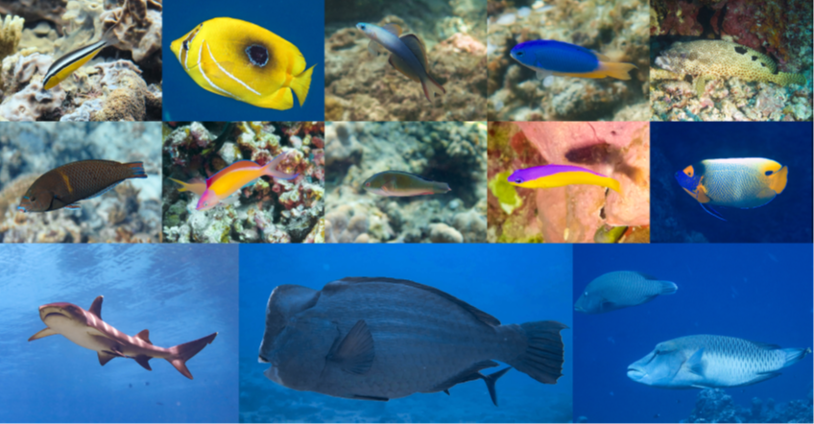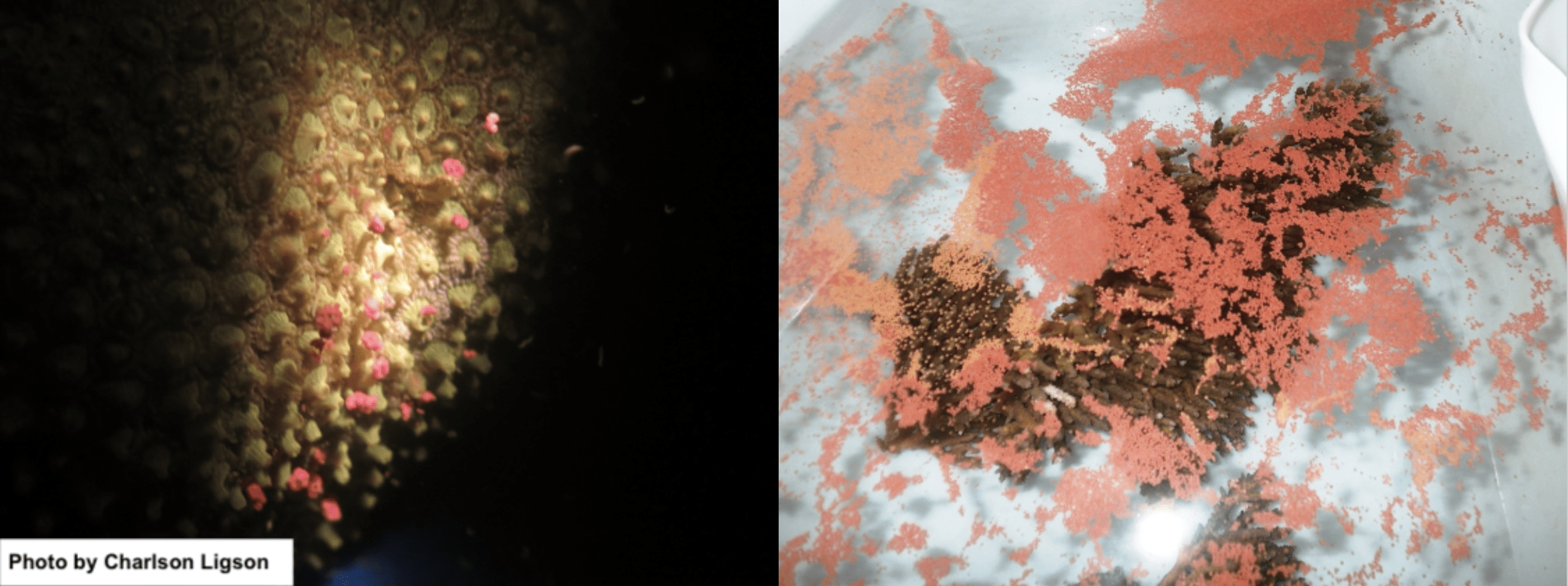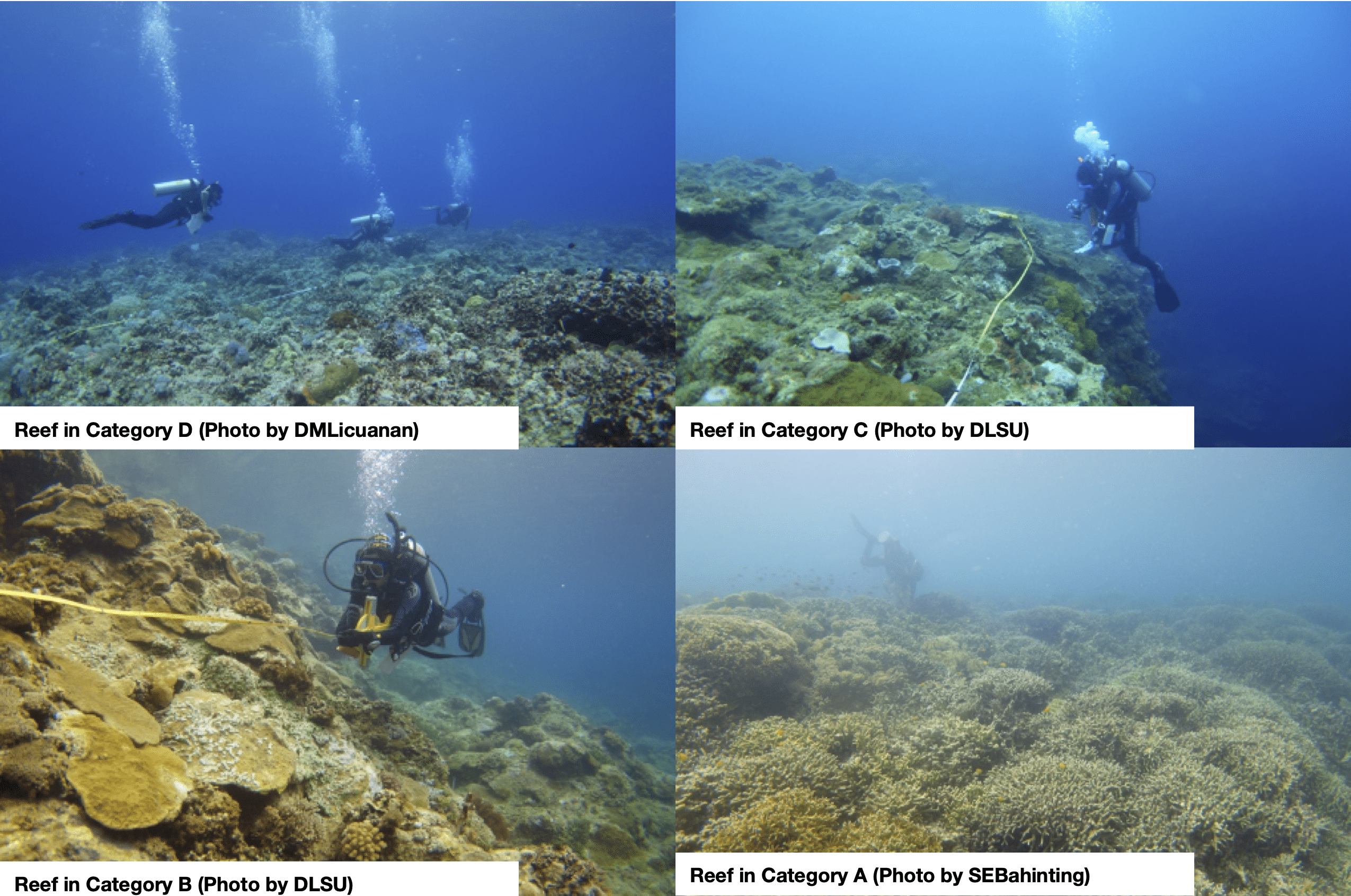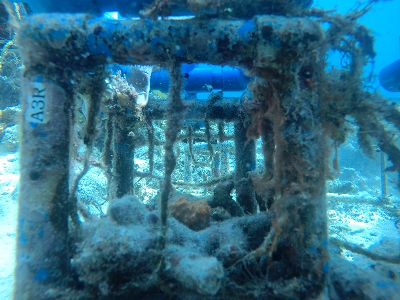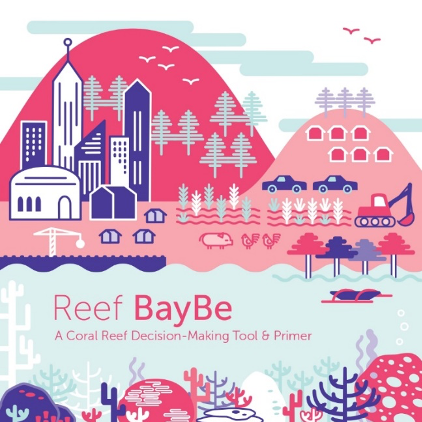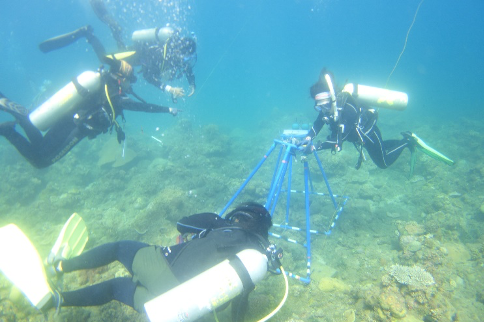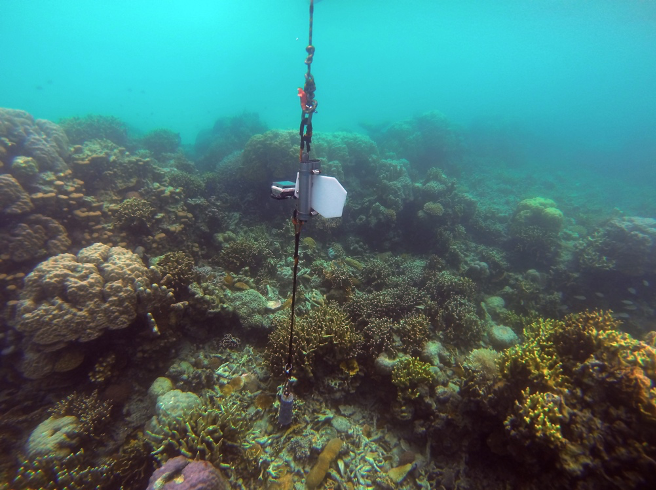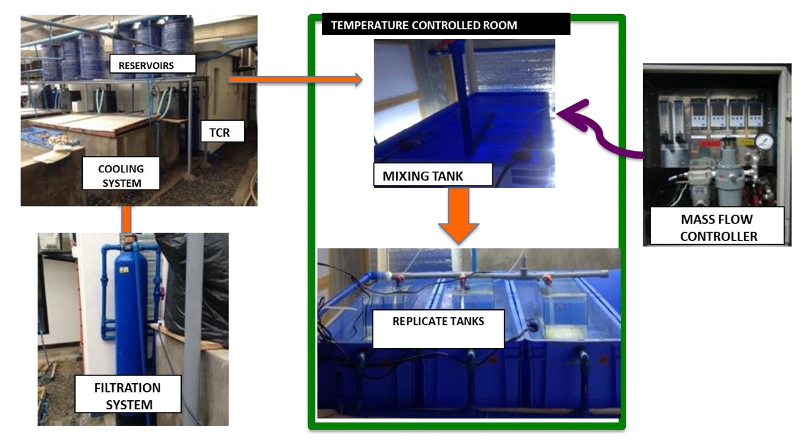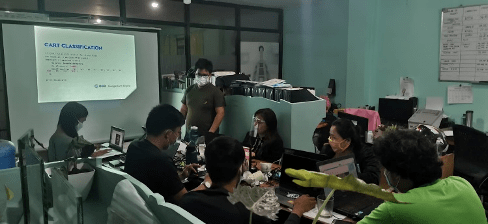Coral
Industry Strategic Science and Technology Program
Coral Industry Profile
The Philippines’ coral reef area of 26,000 square kilometers (km2) is the 2nd largest in Southeast Asia. There are approximately 500 species of scleractinian or “hard” corals and 12 of these species are considered endemic or native to the region. Hard corals contain calcium carbonate, a hard substance that turns into rock over time. Some examples of hard corals are Acropora granulosa, Montipora digitata, and Pocillopora damicornis. On the other hand, octocorals or “soft” corals do not form stony skeletons as they remain bendable. At least 10 families of soft corals can be found in the Philippines.
According to the Department of Environment and Natural Resources (DENR), there are around 1,800 established marine protected areas (MPAs) in the Philippines. This includes Tubbataha Reefs Natural Park, Apo Reef Natural Park (ARNP) and Tañon Strait Protected Seascape. There are also 6 marine biogeographic regions, namely: Celebes Sea, Northern Philippine Sea, West Philippine Sea, Southern Philippine Sea, Sulu Sea, and Visayan Sea. The Sulu-Sulawesi Marine Ecoregion and the West Philippine Sea are considered priority seascapes.
Problems in the Industry
The challenges faced by coral industry include limited research and studies on the Philippine coral reefs and its status, gaps in current understanding of the impacts of the climate change related stressors, limited knowledge on coral reef management, overexploitation as coral reefs are often subjected to destructive fishing techniques and excessive harvesting, and limited policies to stop overexploitation and destructive fishing techniques.
Coral Policies
| Policy Type | Policy Number | Policy Year | Congress | Policy Title | Policy Description | Policy Objective | Policy Link | Commodity | Classification | info_encoder_stamp | info_date_stamp | info_quashing_remarks | filepath |
|---|---|---|---|---|---|---|---|---|---|---|---|---|---|
| Order | Executive Order No. 797 | 2009 | Null | Adopting The Coral Triangle Initiative (CTI) National Plan Of Action | Section 1. Adoption of the CTI National Plan of Action (NPOA). The NPOA is hereby adopted as attached to this Order. The NPOA shall serve as the primary framework for the development and implementation of all related plans and programs, on marine and coastal resources management in the country. Section 2. Integration of the NPOA Priority Actions into the National Plans and Programs. All agencies with coastal and marine concerns are hereby instructed to integrate the NPOA priority actions into their corresponding national plans and budgets and contribute to the effective implementation of the NPOA. Section 3. Integration of the NPOA Priority Actions into the Local Plans and Programs. All local government units, especially those within coastal areas, shall take into consideration the NPOA Priority Actions in the preparation and implementation of local development plans and budgets and contribute to the effective implementation of the NPOA. | The order seeks to rationalize the institutional arrangements, plans and programs ogf the country to ensure well-coordinated, consistent decisions and actions concerning the management of the country’s coastal and marine resources. | https://www.officialgazette.gov.ph/2009/05/06/executive-order-no-797-s-2009/ | Coral | Null | Jeff | 11/22/2024 | C:\Users\trist\Documents\Formatting\Output\Coral_2024-11-22_processed.xlsx | |
| Law | Presidential Decree No. 1219, "The Coral Resources Development And Conservation Decree" | 1977 | Null | Section 2. Declaration of Policy. It is hereby declared to be the policy of the State to promote and regulate the exploration, exploitation, utilization and conservation of coral resources, whether existing beneath territorial waters or in the marine economic zone of the Philippines, and to ensure the protection of these resources as provided for under other existing laws. Section 5. Ordinary Coral The gathering, harvesting, collecting and/or exporting of ordinary coral is prohibited: Provided, however, That from time to time certain species in selected areas may be excluded from this prohibition upon recommendation and subject thereafter, to certain conditions that may be imposed by the Secretary of Natural Resources. Section 6. Special Permit. The Secretary of Natural Resources may issue special permit to any person or institution to gather in limited quantities any coral for scientific or educational purposes. Section 7. Concession The exploration, exploitation and utilization of precious and semi-precious coral resources may be made only upon the award of a concession by the Secretary of Natural Resources. | Section 2. Declaration of Policy. It is hereby declared to be the policy of the State to promote and regulate the exploration, exploitation, utilization and conservation of coral resources, whether existing beneath territorial waters or in the marine economic zone of the Philippines, and to ensure the protection of these resources as provided for under other existing laws. Section 5. Ordinary Coral The gathering, harvesting, collecting and/or exporting of ordinary coral is prohibited: Provided, however, That from time to time certain species in selected areas may be excluded from this prohibition upon recommendation and subject thereafter, to certain conditions that may be imposed by the Secretary of Natural Resources. Section 6. Special Permit. The Secretary of Natural Resources may issue special permit to any person or institution to gather in limited quantities any coral for scientific or educational purposes. Section 9. Export of Precious and Semi-Precious Coral Exportation of precious and semi-precious coral gathered is hereby prohibited, unless such corals are first processed and manufactured into finished products in the Philippines. | The decree seeks to regulate the exploration, exploitation, utilization and conservation of coral resources to ensure the preservation of the country’s marine environment. | https://www.officialgazette.gov.ph/1977/10/14/presidential-decree-no-1219-s-1977/ | Coral | Null | Jeff | 11/22/2024 | C:\Users\trist\Documents\Formatting\Output\Coral_2024-11-22_processed.xlsx | |
| Law | Presidential Decree No. 1698 | 1980 | Null | Amending Certain Provisions Of Presidential Decree No. 1219 Dated October 14, 1977, Providing For Re Exploration, Exploitation Utilization And Conservation Of Coral Resources. | “Sec. 4. Implementing Agency. — This Decree shall be implemented by the Bureau of Fisheries and Aquatic Resources, who shall have jurisdiction and responsibility in the exploration, exploitation, utilization and conservation of coral resources.” “Sec. 5. Ordinary Coral. — The gathering, harvesting, collecting, transporting, possession, sale and\or exporting of ordinary corals either in raw or processed form in any quantity, is prohibited. The use of corals as materials in buildings and other man-made structures, such as but not limited to piers, dams, and dikes, is likewise prohibited.” “SEC. 6. Gratuitous Permit. — The Minister of Natural Resources may issue a gratuitous permit to duly established and recognized research and educational institutions to gather in limited quantities any coral for scientific or educational purposes only.” “SEC. 7. Special Permit. — The Minister of Natural Resources may issue a special permit to only one person\corporation for a limited period to conduct experimental collection of precious and semi-precious corals. The applicant for a special permit must be a Filipino citizen, or a corporation, at least seventy (70%) per cent of the capital stock of which is owned or controlled by Filipinos. | The decree seeks to amend PD No. 1219 to reorient our policies with the realities and conditions of our coral reef resources. | https://www.officialgazette.gov.ph/1980/05/22/presidential-decree-no-1698-s-1980/ | Coral | Null | Jeff | 11/22/2024 | C:\Users\trist\Documents\Formatting\Output\Coral_2024-11-22_processed.xlsx | |
| Law | Republic Act No. 7586 | 1992 | 8th | An Act Providing For The Establishment And Management Of National Integrated Protected Areas System, Defining Its Scope And Coverage, And For Other Purposes, “National Integrated Protected Areas System Act of 1992” | 1. All areas or islands in the Philippines proclaimed, designated or set aside, pursuant to a law, presidential decree, presidential proclamation or executive order as national park, game refuge, bird and wildlife sanctuary, wilderness area, strict nature reserve, watershed, mangrove reserve, fish sanctuary, natural and historical landmark, protected and managed landscape/seascape as well as identified virgin forests before the effectivity of this Act are hereby designated as initial components of the System. The initial components of the System shall be governed by existing laws, rules and regulations, not inconsistent with this Act; Buffer Zones. – For each protected area, there shall be established peripheral buffer zones when necessary, in the same manner as Congress establishes the protected area, to protect the same from activities that will directly and indirectly harm it. Such buffer zones shall be included in the individual protected area management plan that shall prepared for each protected area. | The law seeks to establish a National Integrated Protected Areas System (NIPAS), which shall encompass outstandingly remarkable areas and biologically important public lands that are habitats of rare and endangered species of plants and animals, biogeographic zones and related ecosystems, whether terrestrial, wetland or marine, all of which shall be designated as “protected areas”. | https://www.officialgazette.gov.ph/1992/06/01/republic-act-no-7586/ | Coral | Null | Jeff | 11/22/2024 | C:\Users\trist\Documents\Formatting\Output\Coral_2024-11-22_processed.xlsx | |
| Law | Republic Act No. 10067 | 2009 | 14th | An Act Establishing The Tubbataha Reefs Natural Park In The Province Of Palawan As A Protected Area Under The Nipas Act (R.A. 7586) And The Strategic Environmental Plan (Sep) For Palawan Act (R.A. 7611), Providing For Its Management And For Other Purposes | It shall further be the policy of the State to promote the Tubbataha Reefs, with the end in view of fostering widespread awareness and concern for the same. Towards this end, the State shall undertake to carry out comprehensive and holistic promotions, training and information campaign programs for the benefit of the general public, in pursuance of the duty of the State to uphold the primacy of protecting, preserving and promoting these resources. The Tubbataha Reefs Natural Park (TRNP), which shall cover an approximate area of ninety-seven thousand thirty (97,030) hectares, including its islets, seabed and airspace, and which shall include the Tubbataha Reefs and the Jessie Beazley Reef in the Municipality of Cagayancillo in the Province of Palawan, is hereby declared as a protected area. | The law seeks to to ensure the protection and conservation of the globally significant economic, biological, sociocultural, educational, and scientific values of the Tubbataha Reefs into perpetuity for the enjoyment of present and future generations. | https://www.officialgazette.gov.ph/2010/04/06/republic-act-no-10067/ | Coral | Null | Jeff | 11/22/2024 | C:\Users\trist\Documents\Formatting\Output\Coral_2024-11-22_processed.xlsx | |
| Law | Republic Act No. 8550 | 1998 | 10th | An Act Providing For The Development, Management And Conservation Of The Fisheries And Aquatic Resources, Integrating All Laws Pertinent Thereto, And For Other Purposes, "Philippine Fisheries Code" | SECTION 91. Ban on Coral Exploitation and Exportation. — It shall be unlawful for any person or corporation to gather, possess, sell or export ordinary precious and semi-precious corals, whether raw or in processed form, except for scientific or research purposes. Violations of this provision shall be punished by imprisonment from six (6) months to two (2) years and a fine from Two thousand pesos (P2,000.00) to Twenty thousand pesos (20,000.00), or both such fine and imprisonment, at the discretion of the court, and forfeiture of the subject corals, including the vessel and its proper disposition. The confiscated corals shall either be returned to the sea or donated to schools and museums for educational or scientific purposes or disposed through other means. SECTION 92. Ban on Muro-Ami Other Methods and Gear Destructive to Coral Reefs and Other Marine Habitat. — It shall be unlawful for any person, natural or juridical, to fish with gear method that destroys coral reefs, seagrass beds, and other fishery marine life habitat as may be determined by the Department. “Muro-Ami” and any of its variation, and such similar gear and methods that require diving, other physical or mechanical acts to pound the coral reefs and other habitat to entrap, gather or catch fish and other fishery species are also prohibited. | The law seeks to to achieve food security as the overriding consideration in the utilization, management, development, conservation and protection of fishery resources in order to provide the food needs of the population | https://www.officialgazette.gov.ph/1998/02/25/republic-act-no-8550/ | Coral | Null | Jeff | 11/22/2024 | C:\Users\trist\Documents\Formatting\Output\Coral_2024-11-22_processed.xlsx | |
| Order | Executive Order No. 533 | 2006 | Null | Adopting Integrated Coastal Management As A National Strategy To Ensure The Sustainable Development Of The Country’s Coastal And Marine Environment And Resources And Establishing Supporting Mechanisms For Its Implementation | SECTION 1. Integrated Coastal Management (ICM) Policy. ICM and related approaches, such as coastal resource management or coastal zone management, shall be the national management policy framework to promote the sustainable development of the country’s coastal and marine environment and resources in order to achieve food security, sustainable livelihood, poverty alleviation and reduction of vulnerability to natural hazards, while preserving ecological integrity. SEC. 2. Scope and Coverage. ICM shall be implemented in all coastal and marine areas, addressing the inter-linkages among associated watersheds, estuaries and wetlands, and coastal seas, by all relevant national and local agencies. ICM programmes shall promote the application of best practices, such as, but not limited to: c. Protection and rehabilitation of coral reefs, mangroves, seagrass, estuaries and other habitats, particularly through implementation of marine protected areas, nature reserves and sanctuaries; | The order seeks to adopt the Integrated Coastal Management as a national strategy in achieving sustainable coastal and marine development with demonstrated benefits in enhancing economic growth, ecosystem protection, promotion of social equity, and the quality of life of the people | https://www.officialgazette.gov.ph/2006/06/06/executive-order-no-533-s-2006/ | Coral | Null | Jeff | 11/22/2024 | C:\Users\trist\Documents\Formatting\Output\Coral_2024-11-22_processed.xlsx | |
| Law | Presidential Decree No. 1028 | 1977 | Null | Declaring The Entire Sulu And Celebes Seas As An Integrated Conservation And Development Zone, Creating A Presidential Commission For The Integrated Conservation And Development Of The Area And Providing Funds Therefor | The Sulu and Celebes Seas harbor an extremely rich diversity of corals, reef, fish, sea turtles, sea bird, whales, dolphins and large pelagic such as tuna, sharks, jacks, mackerels, whale sharks and manta rays. NOW, THEREFORE, I, FIDEL V. RAMOS, President of the Republic of the Philippines, by virtue of the powers granted to me by law and upon recommendation of the Secretary of Environment and Natural Resources, do hereby declare the Sulu and Celebes Seas as Marine and Coastal Integrated Conservation and Development Zone (MCICDZ). The primary purpose of this proclamation is to conserve the rich biodiversity of the Sulu and Celebes Seas while implementing sustainable development activities particularly in the fisheries and tourism sectors, thus ensuring the economic well-being of coastal communities surrounding the Sulu and Celebes Seas. | The decree seeks to pursue a joint partnership program with local communities and business for maintaining marine conservation areas in the Sulu Sea. | https://www.officialgazette.gov.ph/1997/06/20/proclamation-no-1028-s-1997/ | Coral | Null | Jeff | 11/22/2024 | C:\Users\trist\Documents\Formatting\Output\Coral_2024-11-22_processed.xlsx | |
| Order | Executive Order No. 578 | 2006 | 13th | Establishing The National Policy On Biological Diversity, Prescribing Its Implementation Throughout The Country, Particularly In The Sulu Sulawesi Marine Ecosystem And The Verde Island Passage Marine Corridor | SEC. 3. Guidelines on Critical Habitats and Key Biodiversity Areas. To implement the state policy on biological diversity, the DENR shall, in accordance with law and subject to public consultations, develop and promulgate rules, and regulations for the establishment of critical habitats within key biodiversity areas which are known to harbor habitats and ecosystems critical for the survival of threatened, restricted-range, and congregatory species, and provide the guidelines for their management and protection. Biodiversity impact assessment shall be integrated into the Environmental Impact Assessment and the Environmental Risk Assessment Processes, taking into consideration guidelines adopted under the United Nations Convention on Biological Diversity. SEC. 4. The Presidential Commission for the Integrated Conservation and Development for the Sulu Celebes Seas. The DENR, as Chairman of the Presidential Commission for the Integrated Conservation and Development of the Sulu Celebes Seas created in 1997 by Proclamation No. 1028, otherwise referred to as the Commission, is hereby instructed to immediately undertake the following tasks, viz: (1) review and update the SSME conservation plan; (2) create and organize an Ad Hoc Task Force on Verde Island Passage to ensure the protection, conservation and sustainable use of biological, diversity in the Verde Island Passage Marine Corridor; and, (3) identify other marine biodiversity corridors within the SSME that require urgent attention and formulate appropriate conservation and management strategies. | The decree seeks to establish a national policy that will protect, conserve, and sustainably use biological diversity to ensure and secure the well-being of present. and future generations of Filipinos. This state policy extends to all the components of biodiversity – ecosystems, species and genes. | https://www.officialgazette.gov.ph/2006/11/08/executive-order-no-578/ | Coral | Null | Jeff | 11/22/2024 | C:\Users\trist\Documents\Formatting\Output\Coral_2024-11-22_processed.xlsx | |
| Bill | House Bill No. 2979 | 2019 | 18th | An Act Defining And Providing For More Severe Penalties For Large Scale Exploration And Exploitation Of Corals And Coral Reefs, And Fishing Or Taking Of Threatened Or Endangered Species, And Other Similar Acts Of Destruction Of Our Marine And Aquatic Resources, Further Amending For This Purpose Certain Provisions Of Republic Act No. 8550, Otherwise Known As The Philippine Fisheries Code Of 1998, As Amended By Republic Act No. 10654 | “Section 92. Fishing Through Explosives, Noxious or Poisonous Substance, or Electricity. Upon conviction by a court of law, the offender shall be punished with imprisonment from TWELVE (12) TO TWENTY (20) YEARS [five (5) to ten (10) years], …….. "Section 96. Ban on Coral Exploitation and Exportation - For large scale coral exploitation, the punishment shall be imprisonment from forty (40) years to life imprisonment and the fine as hereinbefore provided. For the purpose of this code, the term "large scale” shall cover corals, extracted or exploited weighing not less than ten (10) kilograms. Large scale destruction of corals, coral reefs, and seagrass beds, through “muro-ami” activities, however, shall be punished with imprisonment from forty (40) years to life imprisonment, or a fine from one million pesos (P1,000,000.00) to ten million pesos (p10,000,000.00) or both such fine and imprisonment, at the discretion of the court. | The bill seeks to amend certain provisions of RA 8550 in order to fortify our drive to protect our natural resources, especially the large scale exploitation of our marine resources, by making the imposable penalties therefor more severe and, hence more deterrent against future violation. | https://www.congress.gov.ph/legisdocs/basic_18/HB02979.pdf | Coral | Null | Jeff | 11/22/2024 | C:\Users\trist\Documents\Formatting\Output\Coral_2024-11-22_processed.xlsx | |
| Bill | House Bill No. 871 | 2020 | 18th | An Act Regulating The Catching, Sale, Purchase, Possession, Transportation, Importation, And Exportation Of Coral Reef Herbivorous Fishes In The Philippines | SECTION 5. Determination of Threatened Species: Vulnerable, Endangered, or Critically Endangered Species. — The DA-BFAR, within three (3) years after the effectivity of this Act and every three (3) years thereafter, shall determine whether coral reef herbivorous fishes are threatened (vulnerable, endangered, or critically endangered) based on available scientific data and with due regard to internationally accepted criteria, such as the International Union for Conservation of Nature (IUCN). Criteria shall include but are not limited to the following: a. Present or threatened destruction, modification, or curtailment of the coral reefs, its habitat or range; b. Over-utilization for commercial, recreational, scientific, or educational purposes; c. Inadequacy of existing regulatory mechanism; and d. Other natural or man-made factor affecting the existence of coral reef herbivorous fishes. a. Size and Catch Ceiling Limitations. — The DA-BFAR may prescribe limitations or quota on the total quantity or size limits on the specie of coral reef herbivorous fishes captured for a specified time and area based on the best available evidence, harvest strategies and target limits. | The bill seeks to institute measures to regulate the catch and trade of coral reel herbivorous fishes. This intends to conserve their population before they become threatened or endangered and maximize their services in maintaining the health of our coral reefs in order to sustain our vital fisheries and tourism industries. | https://www.congress.gov.ph/legisdocs/basic_18/HB04051.pdf | Coral | Null | Jeff | 11/22/2024 | C:\Users\trist\Documents\Formatting\Output\Coral_2024-11-22_processed.xlsx | |
| Order | DENR Administrative Order No. 2013-12 | 2013 | Null | Guidelines for the Implementation of the Sustainable Coral Reef Ecosystems Management Program (SCREMP) | The Sustainable Coral Reef Ecosystems Management is DENR's nationa; program (2012-2020) that will conduct a strategic, sustainable, and ecosystem-based apporach in protecting and rehabilitating coral reef ecosystems within the country through the Protected Areas and Wildlife Bureay (PAWB) -- Coastal and Marine Managememt Office (CMMO) | The DENR AO aims to establish the guidelines of the Sustainable Coral Reef Ecosystems Management Program (SCREMP) | https://bmb.gov.ph/index.php/e-library/laws-and-policies/denr-administrative-orders/dao-2007-2016 | Coral | Null | Jeff | 11/22/2024 | C:\Users\trist\Documents\Formatting\Output\Coral_2024-11-22_processed.xlsx |
ISP for Coral
A number of coral reef areas are still considered to be Category D, with 0-22% hard coral cover (HCC). There is a need to refine and validate coral reef restoration technologies, as well as develop standardized assessment tools and/or decision support systems. Currently, there are also limited studies on the assessment, mapping, and monitoring of fully formed reefs in shallow and mesophotic zones and limited knowledge on coral reef resilience to environmental stressors. The ISP for corals aims to improve coral reef management for sustainable economic, social and ecosystem services such as fisheries, tourism, and coastal protection through the enhancement of culture production, restoration technologies, methods and protocols, and increase understanding of coral responses to threats. The program also targets to capacitate scientists on the use of standardized methods, tools and technologies for reef assessment, as well as to improve the country’s reef management to keep an updated status of the Philippine coral reefs.
Strategic R&D
Strategic R&D is DOST-PCAARRD’s banner program comprising all R&D activities that are intended to generate outputs geared towards maximum economic and social benefits
Community level monitoring programs remain as an important source of primary data that help researchers elucidate important processes in complex systems. The two-year community monitoring...
The Coastal Acidification Program generated information on coastal acidification as a contribution to justify the inclusion of coastal acidification to the National Climate Change Action...
This project studied the genetic structure and connectivity of natural populations of representative coral species with varying dispersal potentials based on life history traits, e.g.,...
Genetic mechanisms that confer stress susceptibility or resilience to corals was determined using RNA-sequencing (RNA-seq) technology. It was discovered that differences in the thermal tolerance...
The physiological limits of 17 selected coral species in response to ocean acidification, ocean warming, and anthropogenic nutrient-coastal acidification stress were evaluated using manipulative experiments....
The reproductive patterns of 18 coral species in Luzon, 13 coral species in Visayas and 11 coral species in Mindanao were assessed while the monthly...
DOST-PCAARRD supported the nationwide coral reef assessment in 2015, which assessed a total of 206 stations using HCC and allowed the development of (1) standardized...
Technologies
Products, equipment, and protocols or process innovations developed to improve productivity, efficiency, quality, and profitability in the agriculture and aquatic industries, and to achieve sustainable utilization and management of natural resources
After a crown of thorns infestation in 2019 followed immediately by consecutive typhoon events, extensive rubble fields have developed in ARNP which have become traps...
The Reef BayBe (A Coral Reef Decision-Making Tool & Primer), is a software with a manual package that integrates quantitative data and experts’ knowledge using...
The protocol is a guide on how to conduct coral assessment from site selection to photo transect method to data processing. This is necessary to...
Culture technologies for sexually-derived coral propagules for reef restoration were developed and summarized in a manual entitled "Culture and rearing techniques of corals from larvae"....
A Rapid Assessment Instrument for Coastal Benthic Habitats (ARAICoBeH) System is a set of low-cost survey equipment that can cover huge areas of both coral...
Capacity Building
Capacity building efforts of DOST-PCAARRD seek to develop and enhance the R&D capabilities of researchers and academic or research institutions through graduate assistantships, non-degree trainings & development, and/or upgrading of research facilities.
Infrastructure Development
Manpower Development
Conducted training on Benthos and Fish Assessments, and Remote Sensing and trained 25 participants from the Apo Reef Natural Park Protected Area Management Office (ARNP-PAMO) personnel and the Sablayan Municipal Environment and Natural Resources Office (MENRO) staff to enhance their management capacity.
Conducted training on Benthos and Fish Assessments, and Remote Sensing and trained 25 participants from the Apo Reef Natural Park Protected Area Management Office (ARNP-PAMO) personnel and the Sablayan Municipal Environment and Natural Resources Office (MENRO) staff to enhance their management capacity.
Policy Research & Advocacy
Analysis of policy concerns and advocacy of science-informed policies ensures that the AANR policy environment is conducive for S&T development and investments.
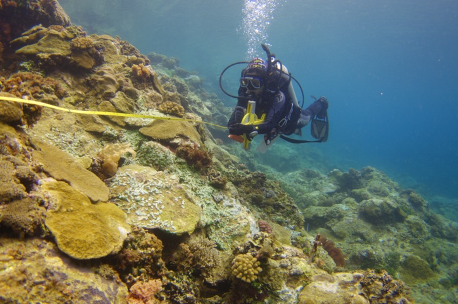
NACRE Program and CBRACT Project
DOST-PCAARRD supported the nationwide coral reef assessment which assessed a total of 206 stations using HCC and allowed the development of national and regional benchmarks, assessment scales and baselines for management-oriented surveys in the future and standardized protocol for reef assessment. These protocols were adopted by the DENR through the three (3) Biodiversity Management Bureau (BMB) Technical Bulletins (Nos. 2019-03 on General Considerations for Coral Reef Ecosystems Restoration/Rehabilitation, 2017-05 on Guidelines on the Assessment of Coastal and Marine Ecosystems and 2019-04 Technical Guide on Biodiversity Assessment and Monitoring System for Coastal and Marine Ecosystems).
DA-BFAR has started to adopt the use of the protocol for reef assessment in all their regional offices through capacity building, wherein a total of 52 participants from 34 institutions in 12 Regions have been trained. Recognizing the need to conduct regular coral reef monitoring, DA also issued Memorandum dated 3 Oct 2019 on Visayas wide AFC Resolution No. 5, Series of 2019 “A Resolution Recommending the Bureau of Fisheries and Aquatic Resources (BFAR) to create an Assessment and Monitoring Team to Conduct Periodic Monitoring of Coral Reefs”. The Red List of Philippines on corals was also updated as required by Republic Act 10654.
Further, based on the results of the program, the PCAF Committee on Fisheries and Aquaculture and the National Fisheries and Aquatic National Resources Management Council (NFARMC) recommended to the Office of the President the amendment of Proclamation No. 2146 (Proclaiming Certain Areas and Types of Projects as Environmentally Critical and Within the Scope of the Environmental Impact Statement System Established under Presidential Decree No. 1586) to expand the scope of Environmental Impact Statement System and prioritize the maintenance and development of corals reefs in the country.
Reference(s):
NACRE Program and CBRACT Project, Dr. Wilfredo Roehl Y. Licuanan/DLSU


